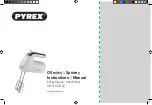
Revision C • 10/07
H
A
R
R
I
S
C
O
R
P
O
R
A T
I
O
N
A-10
Appendix A VMCC
a
.ses
suffix, they do not show up in the Session
selector. If a board operator needs to load a macro,
under 500-series code, the macro can be included
as a “source” when using VMCC to set up the con-
sole, and are then selected on a fader channel just
like signals. When the operator presses
Take on
the fader channel the macro is taken.
In 400-series code, macros must be exclusively
assigned on a fader channel—no audio signals
could be displayed along with the macros. This
limitation is removed in the 500-series operating
system code, which allows intermixed signals and
macros on any fader channel or edge device.
Here is how a standard router definition
([Router_4]) and one set exclusively for loading
macros ([Router_5]) appear in the session file:
[Router_4]
include_1=257-287,321-335
Take=259
[Router_5]
macro_1=dallas
macro_2=chicago
macro_3=tucson
macro_4=bayonne,6
Router 4 is a typical router section with a chan-
nel-specific include list (to limit the sources dis-
played) with a take command to route a signal to
the fader channel when the session file is taken.
Router 5 is set to display only four macros in
its source list using the 400-series code format,
which can also be used in 500-series code. Mac-
ros 1, 2 and 3 are on the local device. Macro 4
(bayonne) is loaded on device 6. Here is the ses-
sion file command syntax for assigning macros to
a router channel:
[Router_x]
Macro_n=Filename,d
x
is the channel ID of the router channel.
n
sequentially numbers the macro entries, start-
ing from 1. Up to 63 macros could be assigned to
any one router channel.
Filename
is the macro’s file name
minus the
.mac
file extension.
,d
is an optional entry to specify a device num-
ber. The device number identifies which device has
the macro file. The macro runs on that device. No
entry says the macro is on the local device.
Alternately, in 500-series code, macros can be
added to the included signals list in the
routers.ini
file by entering the macro file names into VMCC
at the device level:
Once the macro files are included at the device
level, the
routers.ini and the various publish files
are updated by distributing new files to the sys-
tem devices. Macros are then handled as if they
are signals with a special prefix (
M1
,
M2
,
M3
, and
so on). The macro numbers to macro files are iden-
tified at the top of the
local_publish.cfg file:
;macros
mac=1,remote
mac=2,telco_norm
mac=3,request
Here is a typical 500-series channel-specific in-
clude list with both signals and macros in the list.
In the example, the three macros shown in the
publish file example are included:
Include_1_1=D23.65-135,M1-3
Adding Macro File Names into VMCC is Done
at the Device Level in 500-Series Code
Macro Files are Also Included at the Device Level
Содержание RMXDIGITAL
Страница 2: ...Revision C 10 07 H A R R I S C O R P O R A T I O N ii...
Страница 90: ......









































